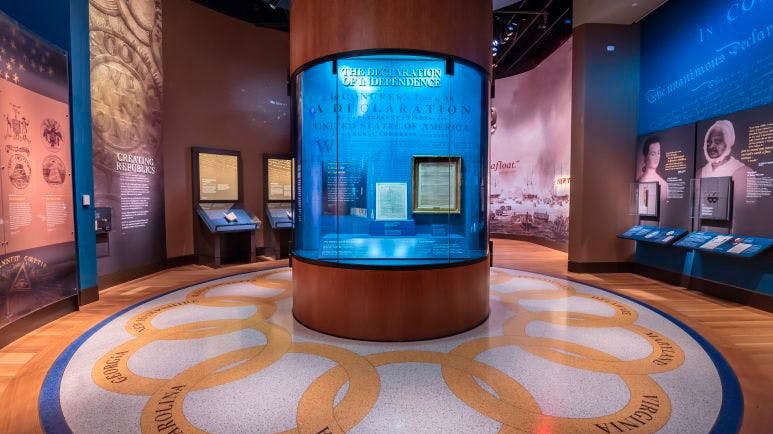Press Releases
Rare 1776 Dunlap Printing of the Declaration of Independence Now on Display in Philadelphia for July 4th
June 26, 2018The Parchment Broadside is the Only One of its Kind Known to Exist
With July 4 quickly approaching, a truly one-of-a-kind artifact is now on display: one of the first printed versions of the Declaration of Independence, a broadside printed on parchment by Philadelphian John Dunlap in July 1776.

Beginning June 26, this unique printing will be on display at the Museum of the American Revolution, just two blocks from Independence Hall, where the revolutionary document was debated and adopted. It will remain on display until November.
This marks the first time the broadside has ever been displayed outside the walls of American Philosophical Society Library (APS), the institution that has loaned it to the Museum.
“We are honored to be able to share this extraordinary treasure of the American founding with our visitors this summer,” said Dr. R. Scott Stephenson, Vice President of Collections, Exhibitions and Programming for the Museum. “It is humbling to stand in the presence of such an authentic witness to our nation’s birth.”
The rare document was printed by John Dunlap, an Irish immigrant who also produced the first public versions of the Declaration on the night of July 4, 1776. Of the estimated 200 original broadsides printed by Dunlap, 26 are currently known to exist (one of these also is in the collection of APS).

Unlike these broadsides, which were printed on paper, the document to be displayed at the Museum is made of vellum, or parchment, and features oversized print. It is the only one of its kind known to exist.
“This document has an incredible history to tell. We are thrilled to share it with the American people this July 4,” said Dr. Patrick Spero, Director of the American Philosophical Society Library. “According to our records, this is the first time we have ever let this parchment leave our buildings, and we couldn’t think of a better institution than the Museum to be its temporary home for celebration of Independence Day.”
The broadside belonged to David Rittenhouse, the Philadelphia astronomer and vice president of the convention that drafted Pennsylvania’s state constitution in 1776. It descended from Rittenhouse's family to physician James Mease, who donated it to the American Philosophical Society in 1828.
The printing will be displayed in a cylindrical case in the Museum’s Declaration of Independence Gallery. The gallery also explores what the Declaration’s promise of “equality” meant for all people, including women, enslaved people, and laboring men. In an adjacent mini-theater that evokes the inside of Independence Hall, a film explores the tumultuous weeks leading up to the adoption of the Declaration. Through a touchscreen installation, visitors learn about the 88 local declarations of support for independence that preceded the one issued by the Continental Congress.
The display is free with regular Museum admission. The Museum will offer music, costumed interpreters and other festivities throughout July 4th weekend. More information is available here.
About the American Philosophical Society
The American Philosophical Society, the oldest learned society in the United States, was founded in 1743 by Benjamin Franklin for the purpose of “promoting useful knowledge.” In the 21st century we sustain this mission in three principal ways. We honor and engage leading scholars, scientists, and professionals through elected membership and opportunities for interdisciplinary, intellectual fellowship, particularly in our semi-annual Meetings. We support research and discovery through grants and fellowships, lectures, publications, prizes, exhibitions, and public education. We serve scholars through a research library of manuscripts and other collections internationally recognized for their enduring historic value. The American Philosophical Society’s current activities reflect the founder’s spirit of inquiry, provide a forum for the free exchange of ideas, and convey our conviction that intellectual inquiry and critical thought are inherently in the best interest of the public.
About Museum of the American Revolution
The Museum of the American Revolution explores the dramatic, surprising story of the American Revolution through its unmatched collection of Revolutionary-era weapons, personal items, documents, and works of art. Immersive galleries, powerful theater experiences, and digital touchscreens bring to life the diverse array of people who created a new nation against incredible odds. Visitors gain a deeper appreciation for how this nation came to be and feel inspired to consider their role in the ongoing promise of the American Revolution. Located just steps away from Independence Hall, the Museum serves as a portal to the region’s many Revolutionary sites, sparking interest, providing context, and encouraging exploration. The Museum, which opened on April 19, 2017, is a private, non-profit, and non-partisan organization. For more information, visit www.AmRevMuseum.org or call 877.740.1776.